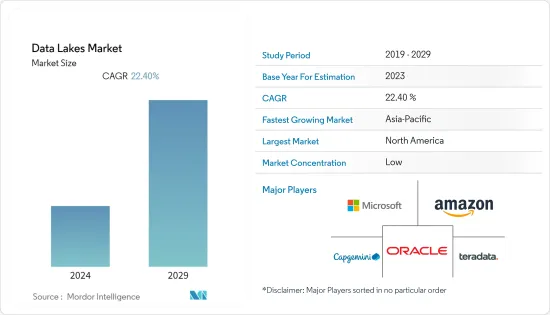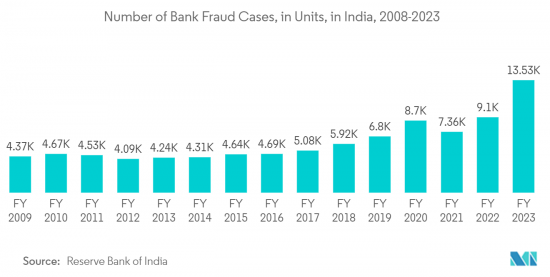 |
市場調查報告書
商品編碼
1404392
資料湖 -市場佔有率分析、產業趨勢/統計、2024 年至 2029 年成長預測Data Lakes - Market Share Analysis, Industry Trends & Statistics, Growth Forecasts 2024 - 2029 |
||||||
※ 本網頁內容可能與最新版本有所差異。詳細情況請與我們聯繫。
今年資料湖市場規模預估為111.4億美元,複合年成長率為22.4%,預計五年後將達377.6億美元。
資料湖是一個中央儲存庫,存儲大量資料、結構化、半結構化和非結構化資料,資料希望從資料中獲取有價值資料的組織而言,它是寶貴的資產。

主要亮點
- 巨量資料的興起和對高級分析解決方案的需求增加了對資料湖的需求。公司希望有效地儲存和處理大量不同的資料。
- 物聯網(IoT)的採用導致資料激增是資料湖市場的主要驅動力。物聯網設備通常會即時產生大量資料。資料湖可以處理大量資料的湧入,而不會降低效能。
- 資料湖使組織能夠利用先進的分析能力,並在當今資料主導的業務形勢中獲得競爭優勢。隨著企業不斷認知到資料主導洞察的重要性,對具有高級分析功能的資料湖的需求預計將會成長。
- 啟動延遲和資料整合挑戰是限制市場上資料湖成長和採用的主要因素。將各種來源的資料整合到資料湖中既複雜又耗時。組織可能以不同的格式、資料庫和系統儲存資料,協調和有效地整合資料需要付出巨大的努力。
- COVID-19大流行加劇了消費行為的變化,包括網路購物、遠距學習、虛擬醫療保健和資料產生的增加。資料湖為處理和分析各行業的大量資料流提供了合適的解決方案。
資料湖市場趨勢
BFSI 領域的最終用戶預計將佔據主要市場佔有率
- BFSI 部門產生並處理大量資料,包括客戶交易資料、帳戶資訊、金融市場資料、保險申請和信用評分。資料湖為 BFSI 組織提供了可擴展且靈活的解決方案來管理、處理和分析大量不同的資料。
- 資料湖使 BFSI 組織能夠整合和分析多個來源的客戶資料,包括銀行交易、信用卡使用和線上交易。這種統一的視圖可幫助您獲得有關客戶行為、偏好和需求的寶貴見解,從而促進個人化和有針對性的行銷。
- 資料湖是儲存各種類型資料的中心位置,例如交易資料、使用者行為模式和歷史記錄。透過應用先進的分析和機器學習演算法,BFSI 組織可以更有效地偵測和防止詐欺。
- 據印度儲備銀行稱,2023會計年度,印度儲備銀行(RBI)報告全印度發生了超過13,000起銀行詐騙案件。與上年度相比,這一數字有所增加,扭轉了過去十年的趨勢。銀行詐騙總額從 1.38 兆印度盧比(170 億美元)下降至 3,020 億印度盧比(36.8 億美元)。
- BFSI產業面臨信用風險、市場風險、營運風險等多種風險。資料湖使銀行和保險公司能夠集中和分析風險相關資料,以做出資訊的決策、管理風險並遵守監管要求。
- 許多公司正在推出和開發銀行和金融解決方案。 2022 年 9 月,為 Web3 公司創建第一個金融資料湖的 Tres 是一家由 Bold Start Ventures主導、F2、Mantis、New Form、The Chainsmokers、Blockdaemon Ventures、Kenetic 和 Alchemy 等支持的種子公司,宣布其已在第一階段籌集了760 萬美元。

預計北美將佔據較大市場佔有率
- 北美是採用資料湖的領先地區之一,其推動因素有很多,包括大量精通技術的行業、雲端基礎設施以及對資料主導決策的高度重視。
- 北美是許多資料密集型行業的所在地,包括 IT、通訊、BFSI、醫療保健、零售和製造。這些行業產生的大量資料正在推動對資料湖作為可擴展且靈活的資料儲存和處理解決方案的需求。
- 雲端運算將繼續存在並被廣泛採用。雲端基礎的資料湖具有眾多優勢,包括成本效率、可擴展性和易於部署,這使其成為各種規模企業的有吸引力的選擇。
- 北美公司是先進分析和人工智慧 (AI) 技術的早期採用者。資料湖透過為大型、多樣化的資料集集提供中央儲存庫,為這些資料驅動的應用程式奠定了基礎。
- 物聯網 (IoT) 和巨量資料技術的發展正在該地區產生大量不同的資料。資料湖適合處理來自物聯網設備和巨量資料來源的複雜且大量的資料。
資料湖產業概況
資料湖市場由 Microsoft Corporation、Amazon.com Inc.、Capgemini SE、Oracle Corporation 和 Teradata Corporation 等主要企業瓜分。市場參與企業正在採取聯盟和收購等策略來增強其產品供應並獲得永續的競爭優勢。
2022 年 10 月,Capgemini SA宣布長期客戶Panasonic Automotive Systems將收購其資料生態系統。這個新平台將幫助組織改善資料驅動決策和開發新想法。這使得提取更有效率、可靠。
2022 年 8 月, 資料發布了 VantageCloud Lake,這是一款基於下一代雲端原生架構建構的資料產品。 VantageCloud Lake 以資料深厚的歷史和專業知識為基礎,將 Teradata Vantage 在雲端中經過驗證的強大功能(稱為 VantageCloud Enterprise)引入其核心的雲端原生、自動彈性、低成本物件儲存中。產品設計為易於使用、易於擴充、易於擴充。
其他福利:
- Excel 格式的市場預測 (ME) 表
- 3 個月分析師支持
目錄
第1章簡介
- 研究假設和市場定義
- 調查範圍
第2章調查方法
第3章執行摘要
第4章市場洞察
- 市場概況
- 產業吸引力-波特五力分析
- 供應商的議價能力
- 買方議價能力
- 新進入者的威脅
- 替代品的威脅
- 競爭公司之間的敵對關係
- 產業價值鏈分析
- 評估 COVID-19 對產業的影響
第5章市場動態
- 市場促進因素
- 透過物聯網傳播資料
- 需要先進的分析能力
- 市場抑制因素
- 資料湖上線和資料整合延遲
第6章市場區隔
- 透過提供
- 解決方案
- 按服務
- 按發展
- 雲端基礎
- 本地
- 按行業分類
- 資訊科技/通訊
- BFSI
- 醫療保健
- 零售
- 製造業
- 按行業分類的其他最終用戶
- 按地區
- 北美洲
- 美國
- 加拿大
- 歐洲
- 英國
- 德國
- 法國
- 義大利
- 歐洲其他地區
- 亞太地區
- 中國
- 日本
- 印度
- 其他亞太地區
- 拉丁美洲
- 墨西哥
- 巴西
- 阿根廷
- 其他拉丁美洲
- 中東/非洲
- 阿拉伯聯合大公國
- 沙烏地阿拉伯
- 南非
- 中東和非洲其他地區
- 北美洲
第7章競爭形勢
- 主要供應商概況
- Microsoft Corporation
- Amazon.com Inc.
- Capgemini SE
- Oracle Corporation
- Teradata Corporation
- SAP SE
- IBM Corporation
- Solix Technologies Inc.
- Informatica Corporation
- Dell EMC
- Snowflake Computing Inc.
- Hitachi Data Systems
第8章投資分析
第9章市場的未來

Data Lakes Market was valued at USD 11.14 billion in the current year and is expected to register a CAGR of 22.4%, reaching USD 37.76 billion in five years. A data lake is a central repository that stores large volumes of raw, structured, semi-structured, and unstructured data, making it a valuable asset for organizations seeking to extract valuable insights from their data.
Key Highlights
- The rise of big data and the need for advanced analytics solutions fueled the demand for data lakes. Organizations wanted to store and process vast amounts of diverse data types efficiently.
- The proliferation of data due to adopting the Internet of Things (IoT) has been a significant driver of the data lakes market. IoT devices generate an enormous volume of data, often in real time. Data lakes can handle this massive influx of data without compromising performance.
- Data lakes enable organizations to leverage advanced analytics capabilities and gain a competitive advantage in today's data-driven business landscape. As businesses continue to recognize the importance of data-driven insights, the demand for data lakes with advanced analytics features is expected to grow.
- Slow onboarding and data integration challenges have been significant factors restraining the growth and adoption of data lakes in the market. Integrating data from various sources into a data lake can be complex and time-consuming. Organizations may store data in different formats, databases, and systems, requiring significant effort to harmonize and consolidate the data effectively.
- The COVID-19 pandemic increased the changes in consumer behavior, such as increased online shopping, remote learning, virtual healthcare, and data generation. Data lakes provide suitable solutions for handling and analyzing the massive influx of data across various industries.
Data Lake Market Trends
BFSI End-user Vertical Segment is Expected to Hold Significant Market Share
- The BFSI sector generates and handles vast amounts of data, including customer transaction data, account information, financial market data, insurance claims, credit scores, etc. Data lakes provide BSI organizations with a scalable and flexible solution for managing, processing, and analyzing this massive volume of diverse data.
- Data lakes enable BFSI organizations to consolidate and analyze customer data from multiple sources, such as banking transactions, credit card usage, and online interactions. This consolidated view helps gain valuable insights into customer behavior, preferences, and needs, facilitating personalized, targeted marketing.
- Data lakes are a central repository for diverse data types, including transactional data, user behavior patterns, and historical records. By applying advanced analytics and machine learning algorithms, BFSI organizations can detect and prevent fraudulent activities more effectively.
- According to the Reserve Bank of India, In the financial year 2023, the Reserve Bank of India (RBI) reported more than 13 thousand bank fraud cases across India. This was an increase compared to the previous year and turned around the last decade's trend. The total value of bank frauds decreased from INR 1.38 trillion (USD 0.017 trillion) to INR 302 billion (USD 3.68 billion).
- The BFSI Sector faces various risks, including credit, market, and operational risks. Data lakes allow banks and insurance companies to aggregate and analyze risk-related data to make informed decisions, manage exposures, and comply with regulatory requirements.
- Many companies are launching and developing banking and finance solutions. In September 2022, Tres, the company that made the first financial data lake for Web3 enterprises, announced that it had raised USD 7.6 million in a seed phase led by bold start ventures, with help from F2, Mantis, New Form, The Chainsmokers, Blockdaemon Ventures, Kenetic, and Alchemy.

North America is Expected to Hold Significant Market Share
- North America is one of the leading regions in data lake adoption, driven by various factors, including numerous tech-savy industries, cloud infrastructure, and a strong focus on data-driven decision-making.
- North America has many data-intensive industries, such as information technology, telecom, BFSI, healthcare, retail, and manufacturing. The massive volume of data these industries generate drives the demand for data lakes as a scalable and flexible data storage and processing solution.
- Cloud computing is well-established and widely adopted in this region. Cloud-based data lakes offer numerous advantages, including cost-efficiency, scalability, and ease of implementation, making them an attractive choice for businesses of all sizes.
- North American enterprises have been early adopters of advanced analytics and artificial intelligence (AI) technologies. Data lakes provide a foundation for these data-driven applications by offering a centralized repository for diverse and large datasets.
- The growth of the Internet of Things (IoT) and big data technologies in the region generate massive amounts of diverse data. Data lakes are well suited to handle the complexity and volume of data from IoT devices and big data sources.
Data Lake Industry Overview
The Data Lakes Market is fragmented with major players like Microsoft Corporation, Amazon.com Inc., Capgemini SE, Oracle Corporation, and Teradata Corporation. Players in the market are adopting strategies such as partnerships and acquisitions to enhance their product offerings and gain sustainable competitive advantage.
In October 2022, Capgemini announced that long-time client Panasonic Automotive Systems would get a data ecosystem. The new platform can help an organization improve at making decisions based on data and developing new ideas. This can lead to more efficient and reliable extraction.
In August 2022, Teradata announced VantageCloud Lake, Teradata's product built on a next-generation cloud-native architecture. Based on the deep history and Teradata expertise, VantageCloud Lake can bring the proven power of Teradata Vantage in the cloud, called VantageCloud Enterprise, to an offering that is born in the cloud and designed to be automatically elastic and leverage low-cost object store at its core, easy to use and scale.
Additional Benefits:
- The market estimate (ME) sheet in Excel format
- 3 months of analyst support
TABLE OF CONTENTS
1 INTRODUCTION
- 1.1 Study Assumptions and Market Definition
- 1.2 Scope of the Study
2 RESEARCH METHODOLOGY
3 EXECUTIVE SUMMARY
4 MARKET INSIGHTS
- 4.1 Market Overview
- 4.2 Industry Attractiveness - Porter's Five Forces Analysis
- 4.2.1 Bargaining Power of Suppliers
- 4.2.2 Bargaining Power of Buyers
- 4.2.3 Threat of New Entrants
- 4.2.4 Threat of Substitutes
- 4.2.5 Intensity of Competitive Rivalry
- 4.3 Industry Value Chain Analysis
- 4.4 Assessment of Impact of COVID-19 on the Industry
5 MARKET DYNAMICS
- 5.1 Market Drivers
- 5.1.1 Proliferation of Data due to the Adoption of IoT
- 5.1.2 Need for Advanced Analytic Capabilities
- 5.2 Market Restraints
- 5.2.1 Slow Onboarding and Data Integration of Data Lakes
6 MARKET SEGMENTATION
- 6.1 By Offering
- 6.1.1 Solution
- 6.1.2 Service
- 6.2 By Deployment
- 6.2.1 Cloud-based
- 6.2.2 On-premise
- 6.3 By End-user Vertical
- 6.3.1 IT and Telecom
- 6.3.2 BFSI
- 6.3.3 Healthcare
- 6.3.4 Retail
- 6.3.5 Manufacturing
- 6.3.6 Other End-user Verticals
- 6.4 By Geography
- 6.4.1 North America
- 6.4.1.1 United States
- 6.4.1.2 Canada
- 6.4.2 Europe
- 6.4.2.1 United Kingdom
- 6.4.2.2 Germany
- 6.4.2.3 France
- 6.4.2.4 Italy
- 6.4.2.5 Rest of Europe
- 6.4.3 Asia Pacific
- 6.4.3.1 China
- 6.4.3.2 Japan
- 6.4.3.3 India
- 6.4.3.4 Rest of Asia Pacific
- 6.4.4 Latin America
- 6.4.4.1 Mexico
- 6.4.4.2 Brazil
- 6.4.4.3 Argentina
- 6.4.4.4 Rest of Latin America
- 6.4.5 Middle East and Africa
- 6.4.5.1 United Arab Emirates
- 6.4.5.2 Saudi Arabia
- 6.4.5.3 South Africa
- 6.4.5.4 Rest of Middle East and Africa
- 6.4.1 North America
7 COMPETITIVE LANDSCAPE
- 7.1 Key Vendor Profiles
- 7.1.1 Microsoft Corporation
- 7.1.2 Amazon.com Inc.
- 7.1.3 Capgemini SE
- 7.1.4 Oracle Corporation
- 7.1.5 Teradata Corporation
- 7.1.6 SAP SE
- 7.1.7 IBM Corporation
- 7.1.8 Solix Technologies Inc.
- 7.1.9 Informatica Corporation
- 7.1.10 Dell EMC
- 7.1.11 Snowflake Computing Inc.
- 7.1.12 Hitachi Data Systems













